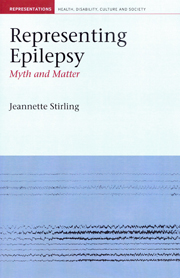Book contents
- Frontmatter
- Contents
- Acknowledgements
- Introduction
- 1 From Hippocrates to Shakespeare and Dickens: epilepsy's entry into ‘the circuit of culture’
- 2 Hystericity and hauntings: the female and the feminised
- 3 Notes from the borderlands: repressing the returned
- 4 The colonies
- 5 Because you're ‘you know. That way’
- Where to next? The ongoing story of epilepsy
- Bibliography
- Index
5 - Because you're ‘you know. That way’
- Frontmatter
- Contents
- Acknowledgements
- Introduction
- 1 From Hippocrates to Shakespeare and Dickens: epilepsy's entry into ‘the circuit of culture’
- 2 Hystericity and hauntings: the female and the feminised
- 3 Notes from the borderlands: repressing the returned
- 4 The colonies
- 5 Because you're ‘you know. That way’
- Where to next? The ongoing story of epilepsy
- Bibliography
- Index
Summary
I am an electrical impulse. I discharge at random across a synapse, at the threshold of a seizure. Grand mal. Idiopathic. Without warning. She cries out. I dance. She waves her arms about, falls. Her pupils dilate, teeth bite into the tongue. I am dancing. Her face is the blue of cyanide. I rampage. Her muscles contract. She convulses. Saliva mixed with blood dribbles from her mouth. She has lost consciousness.
(Susan Hawthorne, The Falling Woman, 1992, original italics)Getting to know you,
Getting to know all about you.
Getting to know you,
Getting to know what to say….
(Richard Rodgers and Oscar Hammerstein, ‘Getting to know you’, 1951)Another century; other cities; other mediums; new technologies. Well into the twentieth century the convulsive figure given literary presence by Charles Dickens, Fyodor Dostoevsky, Thomas Hardy and Robert Louis Stevenson continued to thrive in literature. Visual representations of the seizure-prone body migrate from medical photographic and film projects to mainstream cinema. Films as diverse as The Big Sleep, The Andromeda Strain, Romper Stomper and Deceiver, as well as television shows such as American Gothic and The X Files, all draw upon the metaphorical capital of the epileptic or convulsing body to evoke the threat of chaos lurking beneath a patina of late twentieth-century order.
- Type
- Chapter
- Information
- Representing EpilepsyMyth and Matter, pp. 178 - 230Publisher: Liverpool University PressPrint publication year: 2010



